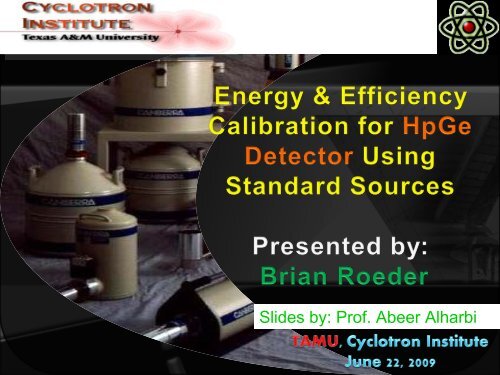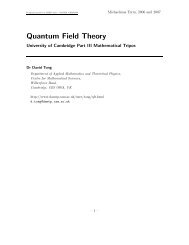Energy and Efficeincy Calibration for HpGe Detector Using Standard ...
Energy and Efficeincy Calibration for HpGe Detector Using Standard ...
Energy and Efficeincy Calibration for HpGe Detector Using Standard ...
You also want an ePaper? Increase the reach of your titles
YUMPU automatically turns print PDFs into web optimized ePapers that Google loves.
Slides by: Prof. Abeer Alharbi
electromagnetic radiation of<br />
high energy. They are<br />
produced by sub-atomic<br />
particle interactions, such as<br />
electron-positron annihilation,<br />
neutral pion decay,<br />
radioactive decay, fusion,<br />
fission or inverse Compton<br />
scattering in astrophysical<br />
processes. Gamma rays<br />
typically have frequencies<br />
above 10 19 Hz <strong>and</strong> there<strong>for</strong>e<br />
energies above 100 keV <strong>and</strong><br />
wavelength less than 10<br />
picometers
Gamma rays: Photoelectric Effect:<br />
This describes the case in which a gamma photon interacts with <strong>and</strong> a<br />
transfers all<br />
of its energy to an orbital electron, ejecting that electron from the atom.<br />
The kinetic energy of the resulting photoelectron is equal to the energy of the incident<br />
gamma photon minus the binding energy of the electron. E e =E γ -E b<br />
The photoelectric effect is thought to be the dominant energy transfer mechanism <strong>for</strong><br />
x-ray <strong>and</strong> gamma ray photons with energies below 50 keV, , but it is much less important<br />
at higher energies.
The top spectrum is from<br />
a scintillation detector.<br />
The bottom is from a<br />
germanium semiconductor<br />
detector.<br />
The superior energy<br />
resolution of the germanium<br />
is evident from the much<br />
narrower peaks, allowing<br />
separation of gamma-ray<br />
energies that are<br />
unresolved in the<br />
scintillator spectrum.
The detector <strong>Energy</strong> <strong>and</strong> efficiency calibration can be found by:<br />
Counting a st<strong>and</strong>ard source of known activity by the detector.<br />
Such as 60 Co, 137 Cs <strong>and</strong> 152<br />
Eu.<br />
St<strong>and</strong>ard<br />
Radioactive isotope T ½<br />
γ-line energies (keV)<br />
60 Co<br />
137 Cs<br />
152 Eu<br />
5.2714 y 1173.228<br />
30.07 y<br />
13.542 y<br />
γ-line intensities<br />
Iγ%<br />
1173.228 99.857<br />
1332.490 99.983<br />
661.657 85.10<br />
121.7817 28.37<br />
244.6975 7.53<br />
344.2785 26.57<br />
411.1165 2.238<br />
444.0 3.125<br />
778.9045 12.97<br />
867.378 4.214<br />
964.10 14.63<br />
1112.07 13.54<br />
1212.948 1.412<br />
1299.14 1.626<br />
1408.011 20.85<br />
Channel<br />
number
Is a relation between gamma ray energies <strong>and</strong> channel number,<br />
which will be used to determine the unknown measured gamma<br />
lines.<br />
Linear line
Example Spectrum: 152 Eu<br />
• For low energy peaks ( < 1.1 MeV), see mainly<br />
photopeaks <strong>and</strong> Compton.<br />
• Should subtract background (peak-fitting) to calculate<br />
“photopeak” efficiency. (Programs gf3, root, etc.)<br />
Figure courtesy: E. Simmons
The detector efficiency is:<br />
a function of the variables that describe the event, but depending<br />
ng<br />
on definition may also include the effects of other events,<br />
dead-time” in the detector or its electronics<br />
e.g. by “dead<br />
caused by a previous event. If these variables are not completely<br />
specified, i.e. if some or all of them are r<strong>and</strong>om variables, then n the<br />
interesting quantity is the expectation value of the detector<br />
efficiency. This expectation value is again often called the<br />
detector efficiency.
Absolute detector efficiency :<br />
Intrinsic detector efficiency :
1. Some radiation goes directly<br />
from the radioactive material<br />
into the detector.<br />
2. Some radiation will backscatter<br />
off the surface into the detector.<br />
3. Some radiation is absorbed by<br />
the detector covering.<br />
4. Most radiation doesn't even get<br />
detected.<br />
5. If the detector was closer, this<br />
radiation would be detected.
In the Low energies<br />
range<br />
In the high energies<br />
range
Correction <strong>for</strong> the Efficiency<br />
A(<br />
E<br />
ε ( E<br />
b<br />
γ<br />
N<br />
( E<br />
0<br />
Δt<br />
γ<br />
r<br />
Δt<br />
1-<br />
τ<br />
A<br />
⎛ τ<br />
live<br />
Eγ ) = ε ( Er<br />
) • bγ<br />
( Er<br />
) • N ( t)<br />
• Δt<br />
• ⎜1−<br />
⎝ Δt<br />
(<br />
0<br />
) = Activity of γ -source at detector<br />
) = Photopeak efficiency (intins. <strong>and</strong> geom.)<br />
r<br />
) = branching ratio to decay energy level<br />
( t)<br />
= strength of<br />
= length of<br />
= "live- time"of<br />
gamma source at time of<br />
measurement (seconds)<br />
measurement (data - acq.)<br />
⎞<br />
⎟<br />
⎠<br />
measurement<br />
• Use efficiency curve from measurement to calculate “true” activity of gamma decay.<br />
• Use to determine in<strong>for</strong>mation such as β-decay branching ratios <strong>and</strong> cross sections.

















